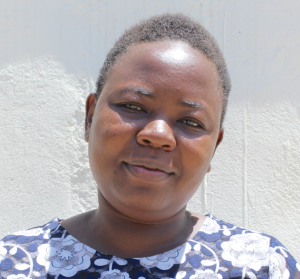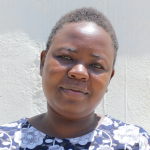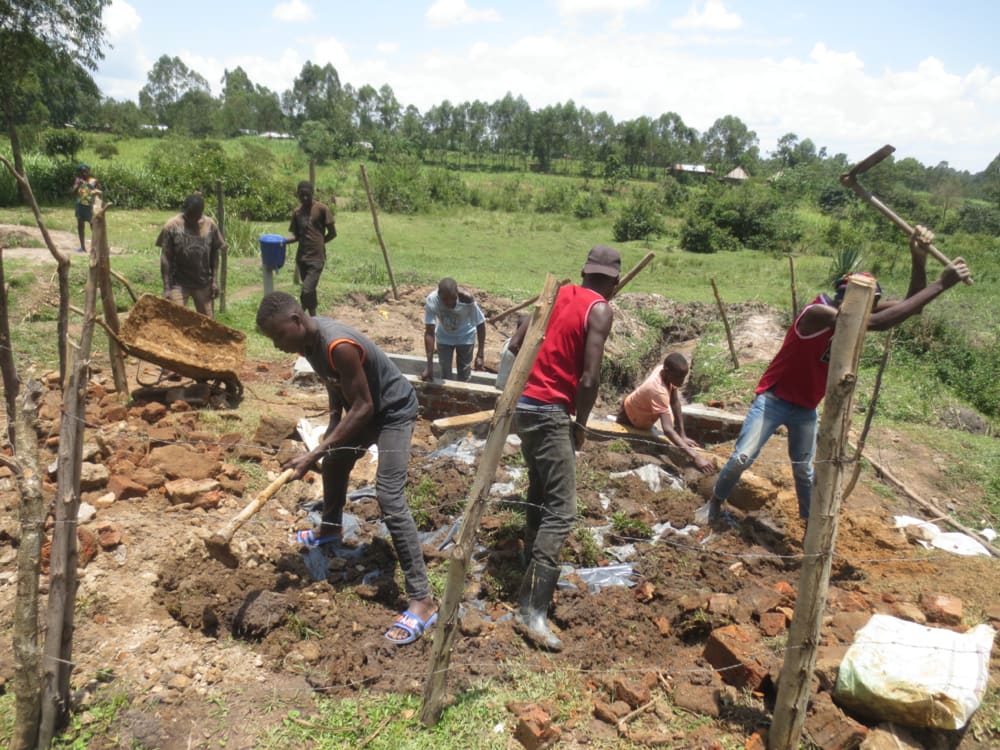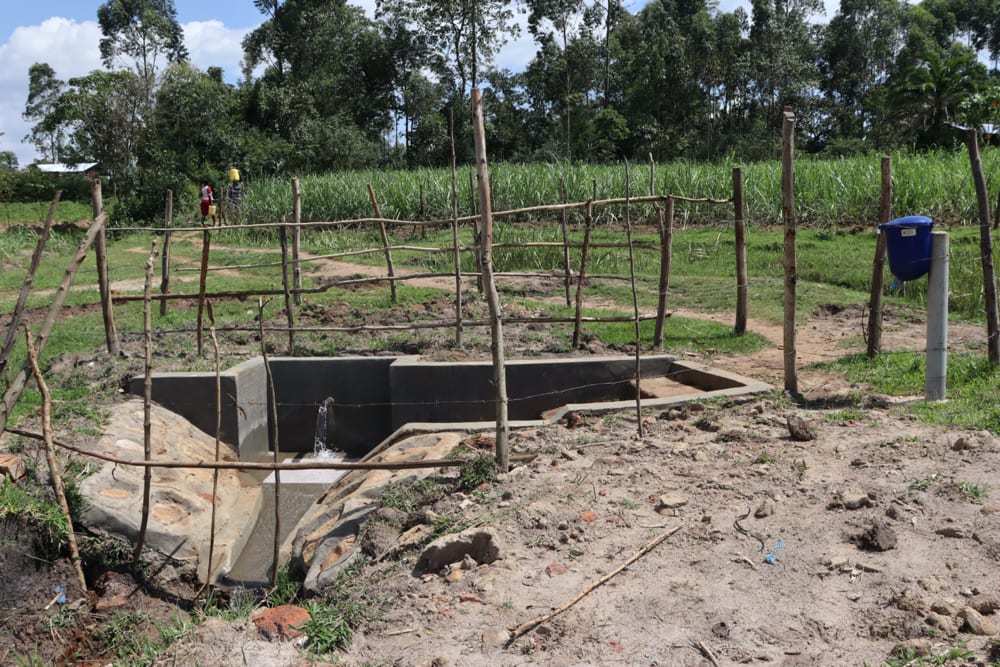Please note: original photos were taken before the COVID-19 pandemic.
Luyingo Spring is found in a very remote area. Farmers ferry their goods to the Butali market, and a majority of people live in houses made of mud walls, iron sheet roofs, and doors made of timber.
For the 280 people who depend on Luyingo Spring for their daily water needs, the spring has quite a few problems. First, it is completely open, resembling a muddy puddle more than anything. The area around it is slippery and muddy, and the rains increase the problematic terrain and contaminated water.
To fetch water, people have to toe up to the water, sometimes stepping into it either by accident or because they have to in order to reach enough water to fill their containers. They typically scoop water with a small cup into their larger jerrycans, which takes a lot of time. Add in the breaks people try to allow between water users to help the water settle of sand and dirt, and there end up being many hours wasted at the spring each day.
The added wait time goes hand in hand with large crowds, which some try to avoid by going to fetch water very early in the morning. It seems they always have to wait in one crowd or another, however, which is particularly problematic during the pandemic when people are trying to avoid large gatherings and time spent in public. The groups and frustration at the spring also lead to disputes between families, disrupting the unity neighbors long for.
"There is normally overcrowding at the spring and at times we need to wait for the elderly people to draw water first... it's very discouraging," reflected teenager Timothy.
Typhoid and amoeba are the most common water-related illnesses community members report after drinking water from Luyingo Spring. These cost money to treat, which drains families of their resources that could be better spent on other needs. It also keeps children home from school when they get sick.
"We have gone through a lot; both money and time have been lost [on this spring], but we thank God for your team that visited us and assured us that they will protect the spring. Forgotten are the days we were affected by waterborne diseases," said 23-year-old farmer Faith Mainja, already imagining the better days ahead following the planned spring protection.
What We Can Do:
Spring Protection
Protecting the spring will help provide access to cleaner and safer water and reduce the time people have to spend to fetch it. Construction will keep surface runoff and other contaminants out of the water. With the community’s high involvement in the process, there should be a good sense of responsibility and ownership for the new clean water source.
Fetching water is a task predominantly carried out by women and young girls. Protecting the spring and offering training and support will, therefore, help empower the female members of the community by freeing up more of their time and energy to engage and invest in income-generating activities and their education.
Training on Health, Hygiene, COVID-19, and More
To hold trainings during the pandemic, we work closely with both community leaders and the local government to approve small groups to attend training. We ask community leaders to invite a select yet representative group of people to attend training who will then act as ambassadors to the rest of the community to share what they learn. We also communicate our expectations of physical distancing and wearing masks for all who choose to attend.
The training will focus on improved hygiene, health, and sanitation habits in this community. We will also have a dedicated session on COVID-19 symptoms, transmission routes, and prevention best practices.
With the community’s input, we will identify key leverage points where they can alter their practices at the personal, household, and community levels to affect change. This training will help to ensure participants have the knowledge they need about healthy practices and their importance to make the most of their water point as soon as water is flowing.
Our team of facilitators will use a variety of methods to train community members. Some of these methods include participatory hygiene and sanitation transformation, asset-based community development, group discussions, handouts, and demonstrations at the spring.
One of the most important issues we plan to cover is the handling, storage, and treatment of water. Having a clean water source will be extremely helpful, but it is useless if water gets contaminated by the time it is consumed. We and the community strongly believe that all of these components will work together to improve living standards here, which will help to unlock the potential for these community members to live better, healthier lives.
We will then conduct a small series of follow-up trainings before transitioning to our regularly scheduled support visits throughout the year.
Training will result in the formation of a water user committee, elected by their peers, that will oversee the operations and maintenance of the spring. The committee will enforce proper behavior around the spring and delegate tasks that will help preserve the site, such as building a fence and digging proper drainage channels. The fence will keep out destructive animals and unwanted waste, and the drainage will keep the area’s mosquito population at a minimum.
Sanitation Platforms
At the end of training, participants will select 5 families that should benefit from new concrete latrine floors called sanitation platforms. Training will inform the community and selected families on what they need to contribute to make this project a success. They must mobilize locally available materials, including bricks, clean sand, and gravel. The 5 families chosen for sanitation platforms must prepare by sinking a pit for the sanitation platforms to be placed over.
All community members must work together to make sure that accommodations and food are always provided for the work teams. The families will then be asked to complete their latrines by constructing a superstructure over their platforms. These 5 sanitation platforms will then serve as examples for the rest of the community to replicate.

 Protected Spring
Protected Spring
 Rehabilitation Project
Rehabilitation Project
















































